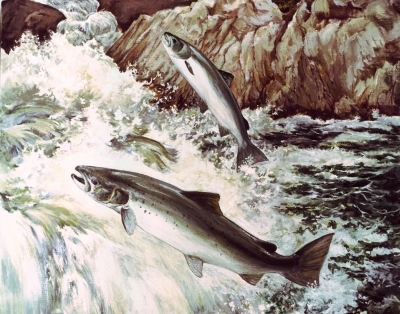Eel River Recovery Project releases 2013-2014 report

The Eel River Recovery Project is releasing the final 2013-2014 Fall Chinook Salmon Monitoring Report that estimates 14,900 to 25,000 Chinook salmon spawned throughout the
watershed last fall and winter. The estimate is based on lower Eel River dive counts and organized observations of migration and spawning throughout the watershed that employ photo and video documentation.
Dozens of volunteer divers once again turned out for ERRP lower Eel River surveys on October 12 and 26, and November 9. The counts built from 1,854 Chinook salmon on the first dive, to 4,224 fish later in the month, and culminated in a record high of 5,954 on the final full organized dive.
Rains from November 19-21 allowed fish passage upstream and Chinook began spawning in all the lower main river reaches in the basin. Chinook salmon moved in small groups with fish stopping to spawn where they found patches of suitable gravel. Due to low rainfall, only a few fish were able to enter the Middle Fork and very few Chinook spawned further upstream on
the South Fork than Leggett and no spawning was documented above Goat Rock falls on the Van Duzen.
On December 5 a small dive team, including a scuba diver, was able to verify that there was a new wave of fresh Chinook in the lower Eel River in Fortuna, when high turbid flows would normally make such observations impossible in most years. These later fish moved upstream within a few weeks and spawned in the main Eel River, mostly below McCann. Spawning was continuous from November 7 to as late as January 28, or for nearly100 days.
Since Chinook only live for a maximum of 24 days after spawning, this suggests there were three or four different distinct runs pulses, each in the thousands. Flow increases from the Potter Valley Project on December 1 drew fish upstream past the Van Arsdale Fish Station, but none had passed prior due to low flows. Only 168 Chinook were counted there in the whole season, which contrasts with last years record run of 3,461 fish.
ERRP also used kayaks and canoes between mid-December and late January to survey more than 30 miles of main Eel River reaches, including the lower South Fork. Salmon nests where eggs are buried are called redds, from the Scottish “to make ready”. In early November one oval nest would appear in an area of clean appropriately sized gravel. Redd numbers increased and then the fish created magnificent, aggregated salmon spawning areas that sometime extended 450 yards.
The last dive reconnaissance on January 29 encountered schools of salmon in the front of the 12th
Street Pool in Fortuna that included a few Chinook but were mostly coho salmon. The rains in the first week in February were perfectly timed for the holding coho, and they successfully spawned in tributaries of the South Fork and in upper tributaries of Outlet Creek near Willits.
Luckily flows never exceeded levels that would scour lower river redds; therefore, it is likely that there may be a very high survival rate of 2013-2014 juvenile Chinook despite record low flows.
The 14,900 to 25,000 fall Chinook estimated by ERRP in the 2013-2014 season is down somewhat from the previous year’s estimate of 20,000 to 50,000 fish. These recent returns are comparable to those of 1955 to 1958 when the last previous basinwide surveys were conducted.
The percentage of jack salmon, which are smaller male salmon that feed for only one year in the ocean, was low in 2013-2014 compared to some recent years. This indicates lower juvenile
Chinook survival and suggests that the ocean and future spawner populations may also taper down.
Funding for this project was made possible by the Patagonia World Trout Fund, the Salmon Restoration Association, Pacific Watershed Associates, Mercer Fraser, and citizens contributing to the ERRP “Penny for a Salmon” project
Go the www.eelriverrecovery.org to obtain a copy of the report.






